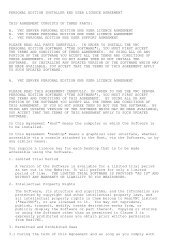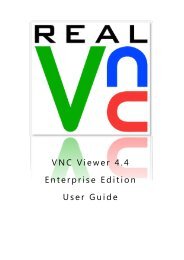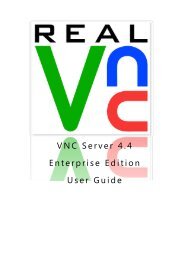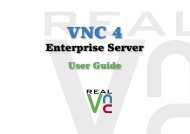VNC User Guide - RealVNC
VNC User Guide - RealVNC
VNC User Guide - RealVNC
You also want an ePaper? Increase the reach of your titles
YUMPU automatically turns print PDFs into web optimized ePapers that Google loves.
Chapter 1: Introduction<br />
5. Make sure <strong>VNC</strong> Server is running on the host computer and that it can accept incoming connections.<br />
See Step 1: Ensure <strong>VNC</strong> Server is running on the host computer on page 20 for more information.<br />
6. Find out the network address of <strong>VNC</strong> Server. If you are connecting:<br />
— Over a LAN or VPN, this must be a private address, which is that of the host computer itself. See<br />
Connecting within a private network on page 27 for more information.<br />
— Over the Internet, this must be a public address, which is that of a router or similar device. See<br />
Connecting over the Internet on page 28 for more information.<br />
7. Find out the credentials required to authenticate to <strong>VNC</strong> Server. By default, if you are connecting to:<br />
— <strong>VNC</strong> Server (Enterprise) or <strong>VNC</strong> Server (Personal), you require the user name and password of a<br />
user account with administrative privileges on the host computer. Note at least one account on the<br />
host computer must have a password set; see Authenticating using host computer user credentials<br />
on page 98 for more information.<br />
— <strong>VNC</strong> Server (Free), you require a password specific to <strong>VNC</strong>. For more information, see<br />
Authenticating using a <strong>VNC</strong> password on page 103.<br />
Note: If you cannot perform these operations and a host computer user is present, you may be able to<br />
jointly perform a reverse connection. See Establishing a reverse connection on page 107 for more<br />
information.<br />
Setting up the client computer<br />
1. Ensure your client computer is turned on, has a functioning operating system, and is connected to the<br />
same network as the host computer.<br />
2. Download <strong>VNC</strong> Viewer from www.realvnc.com/download/viewer/, and save the file to an appropriate<br />
location (depending on the download package chosen, you may need to extract it first). Under UNIX and<br />
Linux, you must also make the file executable, for example by running the command:<br />
chmod +x <br />
Note: Alternatively, you can download and install <strong>VNC</strong> on the client computer, and just run the <strong>VNC</strong><br />
Viewer component, since it does not require a license key. If you do this, <strong>VNC</strong> Viewer can be started<br />
from the menu system of most operating systems, which may be more convenient, and in addition you<br />
can save connections to <strong>VNC</strong> Address Book.<br />
3. If your client computer is protected by a proxy server, specify the details of that proxy server. For more<br />
information, see Connecting via a proxy server on page 36.<br />
12 <strong>VNC</strong> <strong>User</strong> <strong>Guide</strong>
















